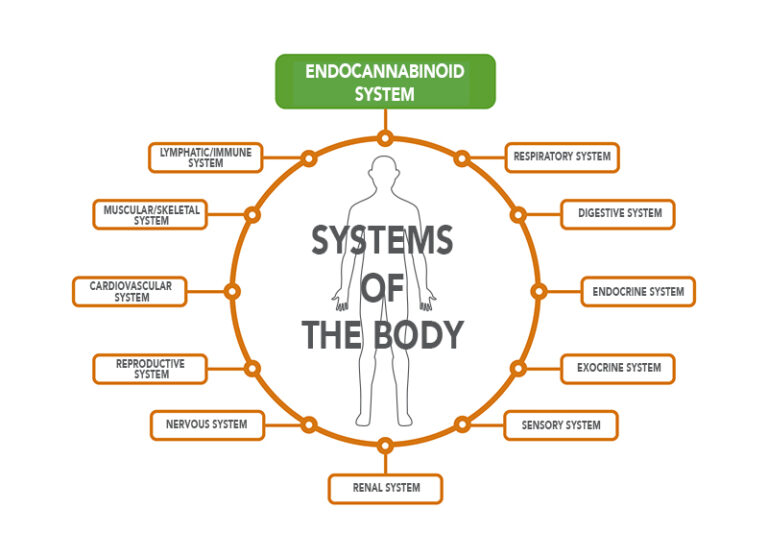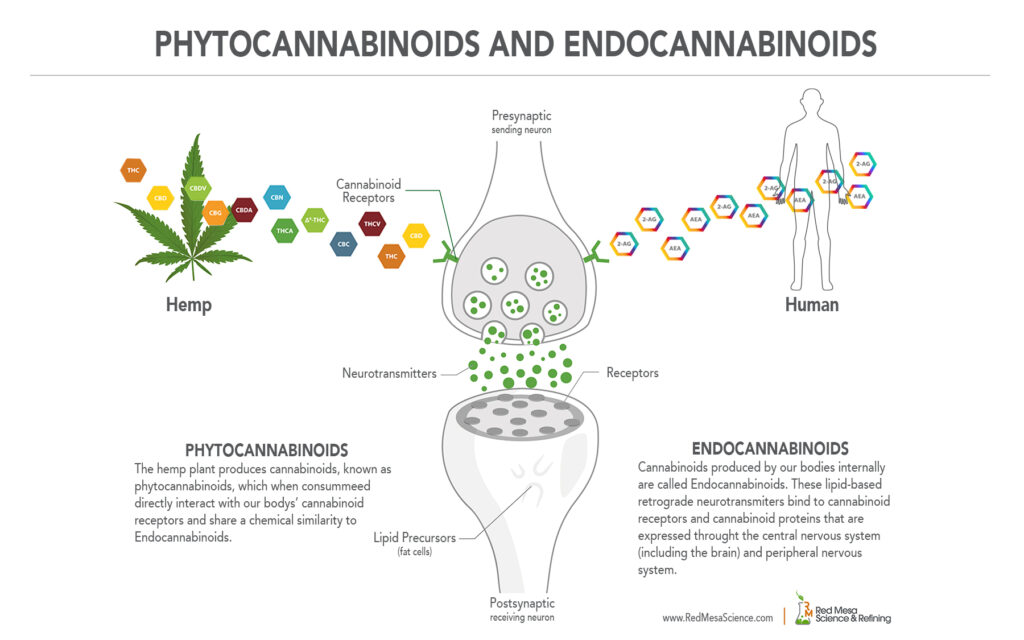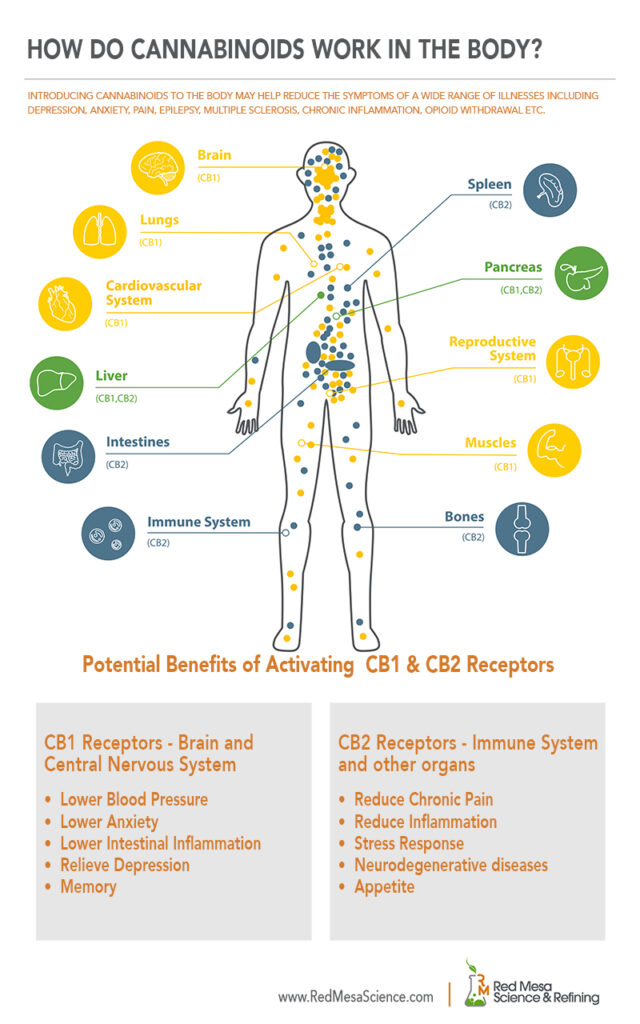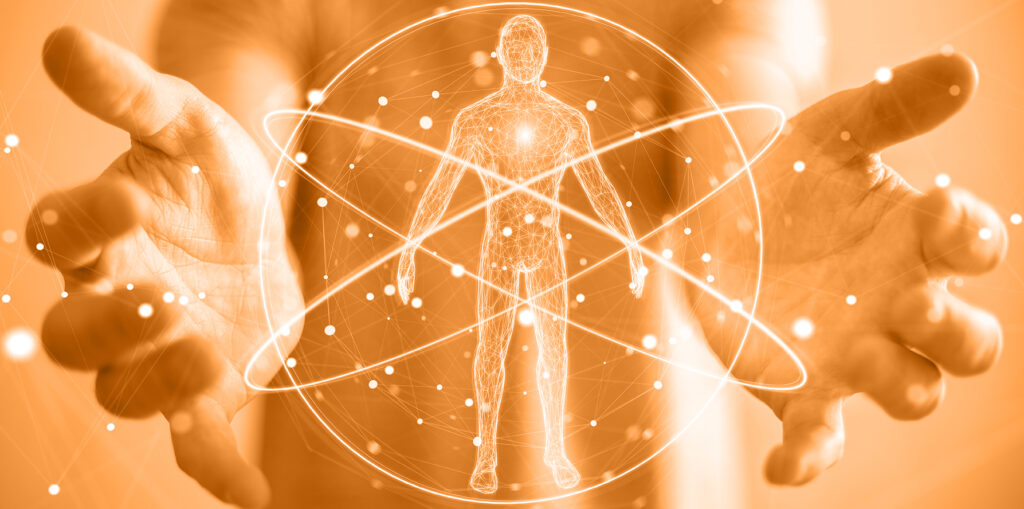How the endocannabinoid system (ECS) works: The key to understanding CBD, CBG, CBN and other cannabinoids
The endocannabinoid system was named “one of the most important physiologic systems involved in establishing and maintaining human health,” according to a study published in the journal Cerebrum. 3
Did you know the Endocannabinoid system is responsible for maintaining:
- Digestion and appetite
- Metabolism
- Immune system functioning
- Inflammation
- Neural Development
- Neuroprotection
- Cardiovascular Function
- Sleep
- Mood
- Reproduction
- Regulation of temperature
- Memory & Learning
- Cognition
- Pain perception
- Pleasure and reward
When considering the use of CBD, CBG, CBN and other hemp-derived cannabinoids, consumers, healthcare providers, wellness practitioners and those who provide access to consumer products are looking to gain an understanding of what the endocannabinoid system is and the differences between cannabinoids, their potential benefits and how they interact with the body’s ECS?
Table of Contents
The History of the Endocannabinoid System (ECS)
Although named after cannabinoids found in the cannabis plant, the endocannabinoid system (ECS) has been present in the body long before humans began using cannabis, evolving over 500 million years. In the 1990s, organic chemist Raphael Mechoulam, an Israeli professor of Medicinal Chemistry at the Hebrew University of Jerusalem, discovered the endocannabinoid system more than 20 years after isolating THC as the psychoactive compound in cannabis.

Understanding the Endocannabinoid System (ECS)
The Endocannabinoid system (ECS) is believed to be one of the most important bodily functions with its failure potentially leading to loss of resilience, illness and even death.
The ECS is an active network of chemical signals and cellular receptors. This network is concentrated in our brains and found abundantly throughout the body. Its job is to maintain a stable environment or homeostasis in the body, regardless of the physiological insult. Living organisms must maintain homeostasis as it is involved in every organ system in the body and is required for the body to properly function and survive.
Homeostasis is the body’s way of ensuring that its internal environment is stable. This includes regulating the temperature, hormone levels, heart rate and more, regardless of the outside environment and external stressors. When the body’s homeostasis is out of balance, the ECS helps to get it back on track. For example, when the body’s temperature rises, perspiration production, facilitated by the ECS, helps to cool the body down.
How the ECS Works
To fully understand the therapeutic effect of exocannabinoids or phytocannabinoids, such as those found in cannabidiol (CBD), cannabigerol (CBG) cannabinol (CBN) and other cannabinoids, it’s imperative to learn how the ECS functions.
The ECS is an essential biological network that sends cellular signals via neurotransmitters. Three key elements exist within the system, working together to regulate various bodily functions by inhibiting or facilitating nerve impulse transmission (i.e., neuromodulation):
- Cannabinoids – Exocannabinoids (plant based or lab produced) or Endocannabinoids (produced within the body)
- Behave as neurotransmitters that send chemical messages.
- Act as keys to “unlock” receptors.
- Different cannabinoids have unique “keys” that can illicit different responses from the same receptor.
- Cannabinoid receptors
- Found in the nervous system and throughout the body.
- Act as “locks” that the cannabinoid “key” bind to in order to initiate biochemical actions.
- Both Exocannabinoids and Endocannabinoids are considered “keys” and bind to the endocannabinoid receptors.
- Enzymes
- Help make and break down cannabinoids

What Are Cannabinoids?
Cannabinoids are chemical messengers that work within the ECS by interacting with specific receptors. Cannabinoids act as keys that unlock the receptors with each evoking a unique response. There are two types of cannabinoids, including endocannabinoids (those naturally made inside the body), and exocannabinoids (those that come from outside sources such as from plants [phytocannabinoids] and lab-made substances).
Endocannabinoids
Endocannabinoids are part of a complex feedback system that regulates and keeps the body in harmony and balance or homeostasis. They are neurotransmitters and are similar to hemp-derived cannabinoids, but they are naturally produced and regulated throughout the human body.
Endocannabinoids are comprised of fatty acids, such as omega-3 fatty acids and glycerol. The human body produces endocannabinoids as they are needed with two primary endocannabinoids being:
- 2-AG (2-archidonoyl glycerol)
- Anandamide (arachidonoyl ethanolamide or AEA)
Endocannabinoids and their receptors are found in the brain, organs, tissues, glands, and immune system cells.5 They function as the bridge connecting the mind and body. 5 Endocannabinoids work on the:
- Immune system
- Nervous system
- Organs (all the body’s organs, including the brain)
Although these specific cannabinoids are found throughout the body, each interacts with a particular receptor type to perform a unique function. For example, Anandamide primarily interacts with CB1 receptors in the brain; 2-AG mainly interacts with CB2 receptors in the immune system5 (read more). Both Anandamide and 2-AG endocannabinoids, control the level of neurotransmitters influencing the intensity and length of responses.
Exocannabinoids
Cannabinoids found in plants (phytocannabinoids) or made in a lab, are referred to as exocannabinoids and will mimic the function of endocannabinoids by stimulating the same receptors to maintain homeostasis. Some of the most common phytocannabinoids include:
- Cannabidiol (CBD)
- Cannabigerol (CBG)
- Cannabinol (CBN)
These exogenous cannabinoids begin as active acids; after cultivation, they must be heated before chemically mimicking their neutral counterparts and used for consumption. While various cannabinoids exist in both the hemp and marijuana cannabis plant, misunderstandings exists between hemp-derived cannabinoids and marijuana derived cannabinoids.
What Is Cannabis: Hemp vs Marijuana?
What is the difference between hemp and marijuana plants?
There is some confusion around and misuse of the term cannabis. Even though marijuana is commonly referred to as Cannabis, technically, both hemp and marijuana come from the cannabis plant (Cannabis genus). However, hemp is of the Cannabis Sativa L plant and legally required restricted to ≤ 0.3% THC, not enough to produce the “high” that the marijuana strains of cannabis would.
The primary difference between hemp and marijuana is that marijuana is specifically bred for high levels of the psychoactive compound delta-9-tetrahydrocannabinol (THC) and hemp is bred for high levels of CBD and other cannabinoids.
| Hemp | Marijuana | |
|---|---|---|
| Is it Cannabis? | Yes | Yes |
| THC Concentration | Low (≤ 0.3% THC per federal guidelines) | High (≥ 0.3% THC normally 5% to 30% THC) |
| CBD Concentration | High | Low |
| Psychoactive | No | Yes |
Cannabinoid Receptors
Endocannabinoids and exocannabinoids bind with the receptor system found in cells throughout the body. When endocannabinoids or exocannabinoids attach to receptors, the ECS is triggered into action through signals. The exocannabinoind and endocannabinoid signaling instructs neurotransmitters to slow down when they fire too quickly—such as when cooling the body down after a fever has done its job. Other examples of where the ECS inhibitory feedback mechanism works:
- Impede the immune response
- Lower blood pressure
- Dilate bronchial passages
- Normalize overstimulated nerves

Researchers have identified and focused on two particular receptors, CB1 And CB2 receptors. Both CB1 and CB2 receptors can be found in many bodily tissues with each receptor being linked with a particular cannabinoid to perform specific roles in maintaining homeostasis.
CB1 Receptors
The CB1 cannabinoid receptors are the most plentiful in the human body.9 (read more). CB1, as cannabinoid receptors, are primarily found in the central nervous system (predominantly in the brain), connective tissue, gonads, glands, and organs, including the pancreas, liver and uterus. When the CB1 receptor is activated, it provides anxiety and pain relief, stabilizes the mood, and induces pleasure and well-being.
CB2 Receptors
Most CB2 receptors are found in the peripheral nervous system, affecting the immune and digestive systems. CB2 receptors are also in the GI tract, gut, spleen, liver, heart, kidneys, bones, blood vessels, lymph cells, endocrine glands and reproductive organs. The CB2 receptor induces anti-inflammatory effects and may also lend itself to generating new nerve cells.
Enzymes
Once the endocannabinoids connect with their specific receptors and have engendered a state of homeostasis, enzymes are released to break the endocannabinoids down. This release ensures that the body does not get out of balance again. For example, once an overheated body has cooled down from perspiring, the ECS does not continue its cooling effect. Releasing these enzymes ensures that the body is not hypothermic.
A Promising Future
In a 2005 paper in the British Journal of Pharmacology, Raphael Mechoulam, the preeminent cannabinoid researcher who discovered the ECS stated –
“I sincerely believe that the plant cannabinoids are a neglected pharmacological treasure trove.” 19
Since then, researchers have been further identifying the role that cannabinoids play in supporting therapeutic potential as it relates to health and wellness via the ECS. Over the next several years, as the legalities evolve and more research is published, it will be even more important to be knowledgeable about cannabinoids and their effect on the endocannabinoid system
Sourcing CBD, CBG, CBN and other cannabinoids
Supplementing bodily endocannbinoid production is gaining momentum as consumers become more educated. It has become critically important to research when sourcing hemp-derived CBD, CBG, CBN and other cannabinoid raw ingredients. To ensure the highest standards of quality and safety, it is imperative that the CBD listed on the product label originates from a trustworthy source with direct access to final Certificates of Analysis (COAs).
Ideally, source from FDA registered hemp processors with ISO 9001:2015 certification, cGMP adherence, and 21 Part 111 and 1117 conformance, all of which indicates the prioritization of product quality and safety.
COAs from an ISO 17025 accredited independent third-party lab adds an additional layer of confidence knowing the lab has been thoroughly evaluated for its technical competence and proficiency (read more). COAs should be full panel and confirm the product’s potency, purity and absence of undesirable compounds.
Resources
- Goldstein B. Cannabis Is Medicine. New York, New York: Little, Brown Spark; 2020.
- Eichhorn BS, Wu BS, Rufyikiri AS, et al. An Update on Plant Photobiology and Implications for Cannabis Production. Frontiers in Plant Science. 2019; 29 March.
- Alger BE. Getting high on the endocannabinoid system. 2013;2013:14. Published November 1, 2013.
- Matias I, Vergoni AV, Petrosino S, et al. Regulation of hypothalamic endocannabinoid levels by neuropeptides and hormones involved in food intake and metabolism: Insulin and melanocortins. Neuropharmacology. 2008;54(1):206-212.
- Zou S, Kumar U. Cannabinoid receptors and the endocannabinoid system: signaling and function in the central nervous system. 2018;19(3):833.
- L. Holderbrand. Hemp & Cannabidiol: What is a Medicine? Mo Med. 2018 Jul-Aug; 115(4): 306-309.
- Baron EP. Comprehensive review of medicinal marijuana, cannabinoids, and therapeutic implications in medicine and headache: what a long strange trip it’s been... Headache: The Journal of Head and Face Pain. 2015;55(6):885-916.
- Congressional Research Service. Defining Hemp: A Fact Sheet. Published March 22, 2019.
- Lu H-C, Mackie K. An introduction to the endogenous cannabinoid system. Biological Psychiatry. 2016;79(7):516-525.
- Mayo Clinic. Healthy Lifestyle Consumer Health. What are the benefits of CBD–and is it safe to use? Updated December 18, 2021.
- Di Marzo V, Piscitelli F. The endocannabinoid system and its modulation by phytocannabinoids. Neurotherapeutics. 2015;12(4):692-698. doi:10.1007/s13311-015-0374-6
- Konieczny E, Wilson L. Chapter 3: The Endocannabinoid System. In: Healing with CBD: How Cannabidiol Can Transform Your Health without the High. Berkeley, CA: Ulysses Press; 2018:45-62.
- Rech GR, Narouze SN. The endocannabinoid system. Cannabinoids and Pain. Published July, 2021:39-45.
- Sulak D. Introduction to the Endocannabinoid System. Published June 29, 2020.
- Iffland K, Grotenhermen F. An update on safety and side effects of cannabidiol: a review of clinical data and relevant animal studies. Cannabis and Cannabinoid Research. 2017;2(1):139-154.
- Zou S, Kumar U. Cannabinoid Receptors and the Endocannabinoid system. Int. J Mol. Sci. 2018, 19, 833. doi: 10.3390/ijms19030833 https://doi.org/10.3390/ijms19030833
- Laprairie R, et al. Cannabidiol is a negative allosteric modulator of the cannabinoid CB1 British J of Pharmacology, 2015. 172(20): p 4790-4805. doi:10.1111/bph.13250 https://doi.org/10.1111/bph.13250
- EPIDIOLEX® (cannabidiol) (cannabidiol) prescribing information. https://www.epidiolexhcp.com/dosing/dosing-and-administration
- Mechoulam R. Plant cannabinoids: a neglected pharmacological treasure trove. Br J Pharmacol. 2005;146(7):913-915. doi:10.1038/sj.bjp.0706415 https://www.ncbi.nlm.nih.gov/pmc/articles/PMC1751232/
Contributing Author: Sherry Christiansen


